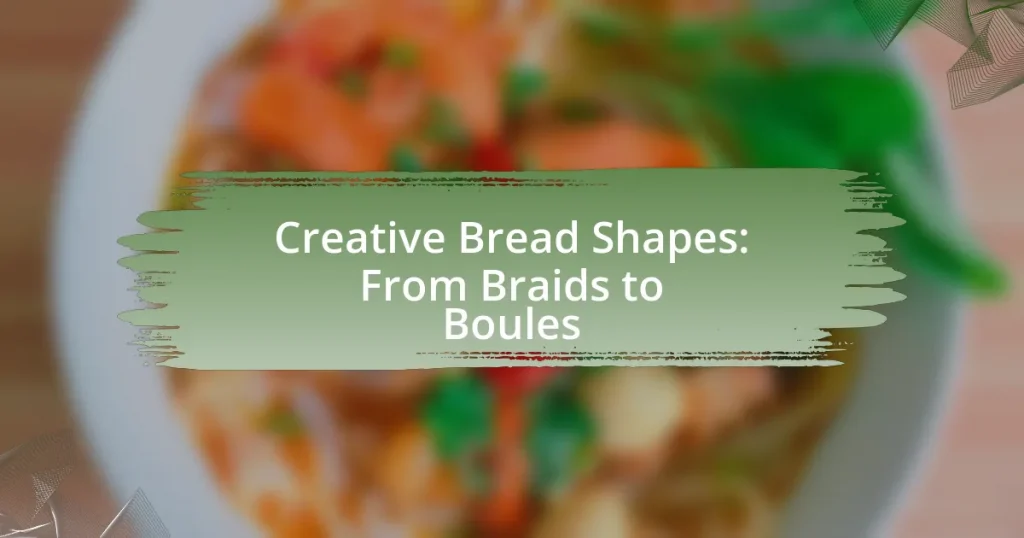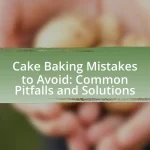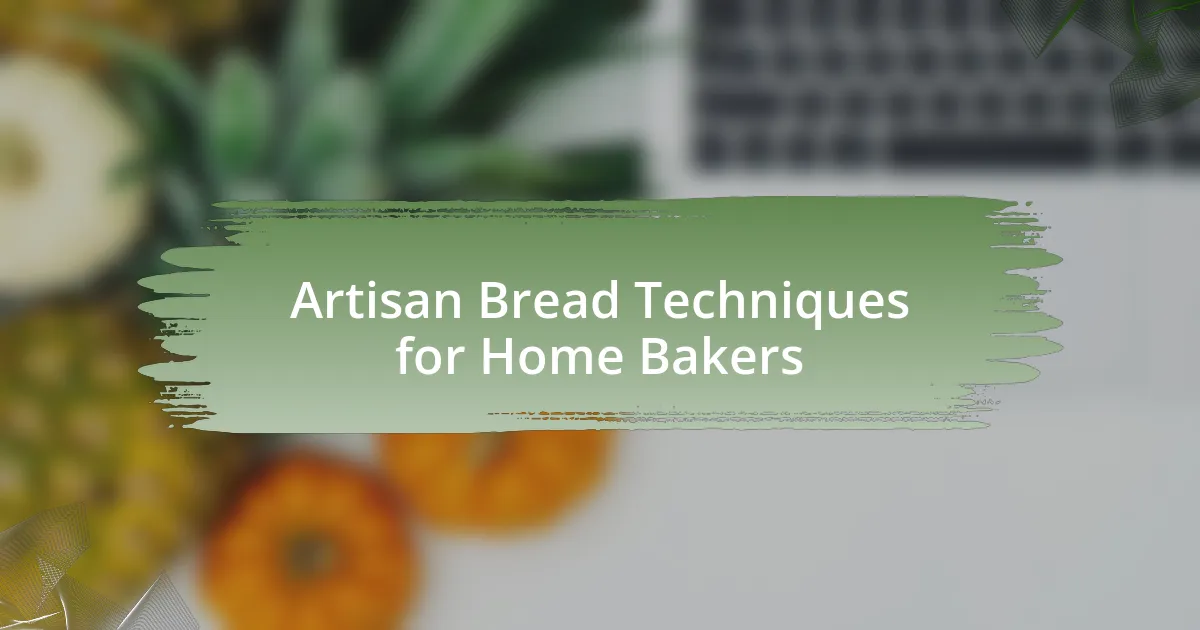Creative bread shapes encompass a variety of artistic forms that extend beyond traditional loaves, including braids, knots, and themed designs. These shapes not only enhance the visual appeal of bread but also reflect cultural traditions and baking techniques, such as the braided challah and the Day of the Dead pan de muerto. The article explores how creative bread shaping enriches the baking experience, the techniques involved in creating unique shapes, and the historical and cultural significance of various bread forms. Additionally, it discusses the impact of shape on the baking process, offers practical tips for shaping bread, and presents ideas for themed bread shapes suitable for special occasions.

What are Creative Bread Shapes?
Creative bread shapes are unique and artistic forms of bread that go beyond traditional loaves, incorporating various designs such as braids, knots, and themed shapes. These shapes not only enhance the visual appeal of the bread but also reflect cultural traditions and baking techniques, as seen in examples like challah, which is braided, and pan de muerto, shaped for the Day of the Dead. The creativity in bread shaping allows bakers to express their artistry while also engaging consumers with visually striking products.
How do creative bread shapes enhance the baking experience?
Creative bread shapes enhance the baking experience by making the process more engaging and visually appealing. When bakers experiment with various forms, such as braids or boules, they not only showcase their skills but also create unique products that can attract attention and stimulate interest in baking. Research indicates that visually appealing food can increase enjoyment and satisfaction, as seen in studies on food aesthetics and consumer behavior. This connection between creativity in shape and enhanced experience underscores the importance of presentation in culinary arts.
What techniques are used to create unique bread shapes?
Techniques used to create unique bread shapes include braiding, shaping, and scoring. Braiding involves intertwining strands of dough to form intricate patterns, commonly seen in challah bread. Shaping techniques, such as folding and rolling, allow bakers to create various forms like boules, batards, and baguettes. Scoring, which entails making cuts on the surface of the dough before baking, not only enhances the aesthetic appeal but also controls the expansion of the bread during baking. These methods are rooted in traditional baking practices and are essential for achieving distinctive visual and textural qualities in bread.
How do different shapes affect the baking process?
Different shapes significantly affect the baking process by influencing heat distribution, moisture retention, and crust formation. For instance, a round loaf, like a boule, bakes more evenly due to its symmetrical shape, allowing heat to penetrate uniformly, while a braided loaf has more surface area, resulting in a thicker crust and potentially drier interior. Research indicates that the shape of bread impacts its final texture and flavor, as seen in studies where loaves of varying shapes were baked under identical conditions, revealing that flatter shapes tend to dry out faster due to increased exposure to heat.
Why are creative bread shapes important in baking culture?
Creative bread shapes are important in baking culture because they enhance visual appeal and signify cultural traditions. The aesthetic variety in bread shapes, such as braids or boules, not only attracts consumers but also reflects the baker’s skill and creativity. Historically, different shapes have been associated with specific rituals or celebrations, such as challah for Jewish Sabbath or panettone for Christmas in Italy, thereby reinforcing cultural identity and community bonds.
What historical significance do various bread shapes hold?
Various bread shapes hold significant historical importance as they often symbolize cultural practices, rituals, and social status. For instance, braided bread, such as challah, is traditionally associated with Jewish Sabbath and holidays, representing unity and the intertwining of life. Similarly, round loaves like boules have been used in many cultures to signify completeness and the cycle of life, often featured in ceremonial contexts. Additionally, specific shapes can denote regional identities; for example, the Italian ciabatta is recognized for its rustic, flat shape, reflecting the agricultural heritage of the region. These shapes not only serve functional purposes in baking but also convey deeper meanings tied to community, tradition, and identity throughout history.
How do cultural traditions influence bread shaping techniques?
Cultural traditions significantly influence bread shaping techniques by dictating the forms and methods used in bread preparation. For instance, in Jewish culture, challah is traditionally braided to symbolize unity and the Sabbath, while in Italy, ciabatta is shaped to resemble a slipper, reflecting regional identity. These techniques are often passed down through generations, preserving cultural heritage and community practices. Historical evidence shows that specific shapes often carry symbolic meanings, such as the round shape of Italian pane di Pasqua representing eternity during Easter celebrations. Thus, cultural traditions not only shape the physical appearance of bread but also embed deeper social and historical significance into the baking process.

What are the Different Types of Creative Bread Shapes?
Creative bread shapes include braids, boules, baguettes, rolls, and focaccia. Braided bread, such as challah, features intertwining strands, while boules are round, rustic loaves. Baguettes are long and thin, characterized by their crispy crust, and rolls can be shaped into various forms, including knots and spirals. Focaccia is flat and often topped with herbs and olive oil. These shapes not only enhance visual appeal but also influence texture and baking characteristics, making them popular in various culinary traditions.
What are the most popular braided bread shapes?
The most popular braided bread shapes include the three-strand braid, the six-strand braid, and the challah shape. The three-strand braid is commonly used for simple loaves, while the six-strand braid creates a more intricate design, often seen in festive breads. The challah shape, which is a specific type of braided bread, is traditionally associated with Jewish cuisine and is characterized by its rich, egg-based dough. These shapes are widely recognized and utilized in various cultures, reflecting both aesthetic appeal and culinary tradition.
How is challah bread braided differently from other types?
Challah bread is braided using a unique three-strand or six-strand technique, which distinguishes it from other types of bread that may use simpler braiding methods. The traditional three-strand braid involves crossing the strands over each other in a specific pattern, while the six-strand braid creates a more intricate design, often resulting in a visually appealing loaf. This complexity in braiding is rooted in Jewish cultural practices, where the braiding symbolizes unity and the intertwining of different elements, particularly during religious observances.
What variations exist in braiding techniques across cultures?
Braiding techniques vary significantly across cultures, reflecting unique traditions and purposes. For instance, in African cultures, intricate cornrow styles serve both aesthetic and cultural identity functions, often symbolizing social status or community belonging. In contrast, European braiding techniques, such as the French braid, emphasize elegance and simplicity, commonly used in hairstyling. Additionally, in Asian cultures, braiding is often incorporated into traditional attire, with styles like the Chinese “double bun” representing historical significance. These variations highlight the diverse meanings and applications of braiding in different cultural contexts.
What are the characteristics of round bread shapes like boules?
Round bread shapes like boules are characterized by their spherical form, which promotes even baking and a chewy crust. The dough used for boules typically contains a high hydration level, resulting in an open crumb structure. Additionally, boules often feature a thick, crispy crust due to the baking method, which usually involves steam to create a desirable texture. The shape allows for a larger surface area, enhancing the Maillard reaction during baking, leading to a rich flavor profile. Boules are traditionally made using simple ingredients such as flour, water, salt, and yeast, reflecting a rustic approach to bread-making.
How does the shape of a boule affect its texture and crust?
The shape of a boule significantly influences its texture and crust by promoting even heat distribution during baking. A round shape allows for a uniform rise, resulting in a consistent crumb structure and a chewy texture. Additionally, the surface area of the boule affects crust development; a well-shaped boule typically has a thicker, crispier crust due to the Maillard reaction occurring evenly across its surface. This is supported by baking science, which indicates that the shape and surface area of bread impact moisture retention and heat exposure, ultimately determining the final texture and crust characteristics.
What are the best practices for shaping a perfect boule?
To shape a perfect boule, start by using a well-hydrated dough that has undergone proper fermentation. After the first rise, gently turn the dough out onto a lightly floured surface and pre-shape it into a loose round. Allow it to rest for 20-30 minutes to relax the gluten. Next, for the final shaping, use your hands to create tension on the surface of the dough by pulling it towards the center and rotating it. This technique helps to form a tight skin, which is essential for a good rise during baking. Finally, place the shaped boule seam-side down in a well-floured proofing basket and cover it to prevent drying out. The proofing time should be adjusted based on the dough’s temperature and humidity, typically ranging from 30 minutes to 2 hours. These practices ensure that the boule maintains its shape and achieves a desirable crust and crumb structure when baked.

How Can You Create Your Own Unique Bread Shapes?
To create your own unique bread shapes, start by manipulating the dough into various forms using techniques such as braiding, twisting, or folding. For instance, braiding involves dividing the dough into three or more strands and intertwining them, which can produce visually appealing loaves. Additionally, you can shape dough into rounds, knots, or even animal shapes by using specific folding methods and tools like a rolling pin or a bench scraper. Historical practices, such as the traditional Italian “pane di Altamura,” showcase how regional techniques influence bread shapes, emphasizing the importance of creativity in bread-making.
What tools and materials do you need for shaping bread?
To shape bread, you need a few essential tools and materials: a clean work surface, a bench scraper, a rolling pin, and flour. The clean work surface allows for proper kneading and shaping, while the bench scraper helps in dividing and lifting dough without sticking. A rolling pin is useful for flattening dough, and flour prevents sticking during the shaping process. These tools are fundamental in achieving various creative bread shapes, such as braids and boules, ensuring that the dough maintains its structure and texture throughout the shaping process.
How do different types of dough influence shaping possibilities?
Different types of dough significantly influence shaping possibilities due to their unique properties, such as hydration levels, gluten development, and fat content. For instance, high-hydration doughs, like ciabatta, allow for more free-form shapes due to their extensibility, while low-hydration doughs, such as bagel dough, are stiffer and better suited for defined shapes like rings. Additionally, enriched doughs containing fats, like brioche, can be shaped into intricate designs because the fat enhances pliability and prevents tearing. These characteristics dictate the techniques bakers can employ, such as braiding, rolling, or molding, ultimately affecting the final appearance and texture of the bread.
What are some common mistakes to avoid when shaping bread?
Common mistakes to avoid when shaping bread include not allowing the dough to rest adequately, which can lead to tight gluten structure and difficulty in shaping. Additionally, using too much flour during shaping can result in a dry exterior and hinder proper rise. Failing to create surface tension by shaping the dough correctly can also prevent the loaf from holding its shape during baking. Lastly, neglecting to properly seal seams when shaping can cause the bread to unravel in the oven. These mistakes can significantly affect the final texture and appearance of the bread.
What tips can help you master creative bread shaping?
To master creative bread shaping, practice techniques such as using a bench scraper for precise cuts, maintaining proper dough hydration for flexibility, and experimenting with different shaping methods like braiding and folding. These techniques enhance control over the dough, allowing for intricate designs. For instance, a study by the American Institute of Baking highlights that dough with higher hydration levels is easier to shape and results in a more open crumb structure, which is desirable in artisan breads. Additionally, regularly practicing various shapes, such as boules and batards, can improve muscle memory and confidence in shaping skills.
How can practice improve your bread shaping skills?
Practice can significantly improve your bread shaping skills by enhancing muscle memory and technique familiarity. Repeatedly shaping dough allows bakers to develop a tactile understanding of the dough’s elasticity and hydration levels, which are crucial for achieving desired shapes. Studies show that consistent practice leads to improved dexterity and precision, enabling bakers to create intricate designs like braids and boules with greater ease and confidence.
What resources are available for learning advanced shaping techniques?
Resources for learning advanced shaping techniques include specialized books, online courses, and instructional videos. Notable books such as “The Bread Baker’s Apprentice” by Peter Reinhart and “Flour Water Salt Yeast” by Ken Forkish provide in-depth techniques and illustrations for advanced bread shaping. Online platforms like MasterClass and Skillshare offer courses specifically focused on advanced bread shaping techniques, often taught by professional bakers. Additionally, YouTube channels dedicated to baking, such as “Baker Bettie” and “Tasty,” feature tutorials that demonstrate various advanced shaping methods. These resources collectively provide comprehensive guidance for mastering advanced shaping techniques in bread making.
What are some creative ideas for themed bread shapes?
Creative ideas for themed bread shapes include animal figures, seasonal symbols, and holiday motifs. For instance, shaping bread into animals like bunnies for Easter or turkeys for Thanksgiving adds a festive touch. Seasonal symbols such as leaves for autumn or snowflakes for winter can enhance the visual appeal of bread. Additionally, holiday motifs like hearts for Valentine’s Day or stars for Christmas provide a thematic connection to celebrations. These creative shapes not only make the bread visually interesting but also engage consumers and enhance the overall dining experience.
How can seasonal themes inspire unique bread shapes?
Seasonal themes can inspire unique bread shapes by reflecting the characteristics and symbols associated with each season. For example, during autumn, bakers often create bread shaped like pumpkins or leaves to celebrate harvest festivals, while winter may inspire shapes resembling snowflakes or holiday ornaments. These shapes not only enhance the visual appeal of the bread but also connect the baking process to cultural traditions and seasonal festivities. Historical practices, such as the creation of Easter bread in braided forms, demonstrate how seasonal themes have long influenced bread artistry, making it a meaningful part of celebrations.
What are some fun shapes for special occasions or holidays?
Fun shapes for special occasions or holidays include stars, hearts, and animals. These shapes are often used in baking and food presentation to enhance the festive atmosphere. For example, star-shaped cookies are popular during Christmas, while heart-shaped treats are common for Valentine’s Day. Additionally, animal shapes, such as bunnies for Easter, add a playful touch to celebrations. These shapes not only serve aesthetic purposes but also engage participants, making the occasion more memorable.




